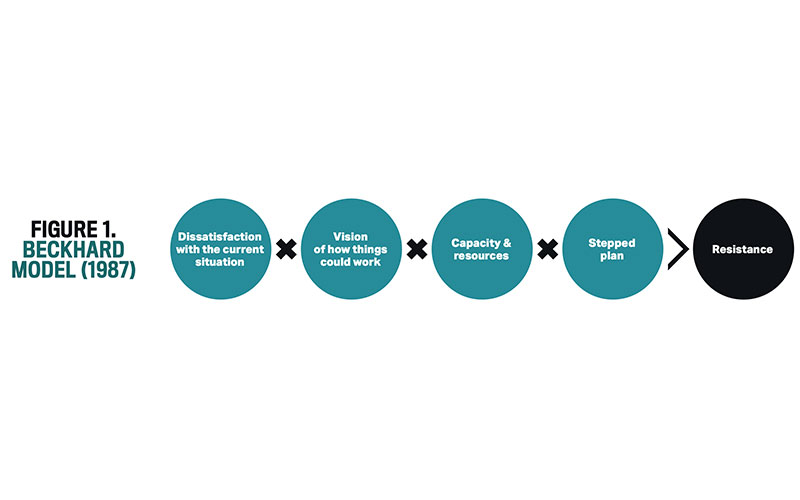Jonny Flanagan, Programme Manager for the Trust Innovation Group at Cumbria, Northumberland, Tyne & Wear NHS Foundation Trust, discusses change culture within organisations.

In an ever-changing and competitive world, industries of all sectors seek to keep abreast of the latest developments, whether it be in terms of research, technology, or through pure profit-based drivers in order to maintain their industry ranking in terms of success and reputation.
Increasingly, organisations seek to implement the most recent translation of change management, from lean methodologies to co-production, and be inclusive of all the latest buzz words, which, in my humble opinion, is the right approach and a welcome change of direction from historic top-down decision-making that often sees the most detached member of an organisation’s processes having the biggest impact on how they evolve and in some instances revolutionise.
But even when carried out with meticulous detail and rigour, often the element of the change that can be the biggest catalyst to theory becoming reality is overlooked – people. From those who will work within and carry a process, to those served by the process change, success is largely dependent on the inclusion of the people within the process in moving from the current state to the new.
In my own experience of change management, this human factor is broken down into four stages:
- Preparing for change
- Letting go of the past
- Change becoming reality
- Reflection and learning.
”Often the element of the change that can be the biggest catalyst to theory becoming reality is overlooked – people”
None of these are standalone but are a sequential set of steps in communicating with those who will be impacted by any change. The boundaries of these steps are not set in stone with the next step dependent on the previous being “completed”– the boundaries are blurred, dependent on the people involved. The careful management of the human factor in change can move as fast or slow as required for the person in question. This does not mean the change must be held up; time may be the enemy of every change agent, whether project/programme manager, team leader or CEO, but the human factor will move through the change the more it is communicated with, but where possible change should be allowed to happen at a pace that suits the needs of those involved.
Preparing for change
The initial human reaction to change is fear – the not knowing how change will impact on personal experience and expectations in the new way of doing things. I’m sure we can all relate to any indication of a change in our lives where we pose the questions in the first instance that look out for our own interests. Why do we have to do this? How will that affect me? Can I be excluded and carry on as normal? Perhaps perceived as a selfish response, it is a natural self-preserving reaction that most will display, even when there is an understanding that the change is necessary.
The Kubler-Ross “Grief Curve” (1969) displays the emotions felt when loss occurs; however, the model extends well to the corporate world, showing the reaction and emotive response from the people affected when the status quo is disrupted by change. The early stages of this curve show a response of shock, fear and denial. In preparation to move through this phase, any change agent must not only seek to answer the questions of why, when, what, but also to understand the ways in which this information will be received.
Transparency of communications is important and needs to start in the opening phase of easing the fears. De Bono perhaps best simplified the differing ways in which personality types will receive and perceive this information with his “Six thinking hats” model (1985), suggesting the main differing types of people whose thought process will react to the pending change in six ways. The message from this is to communicate in understandable language, highlight drivers for the change and evidence supporting them and to allow a forum for the individual to reply with any questions or queries they may need to support their transition through the initial part of the “curve”.

Letting go of the past
As our human factors move through the “curve” we see them move through the gateways of frustration and depression – emotions brought about following an acceptance that change is required but faced with the move to a future state of working and not knowing how to progress.
“You have many habits that weaken you. The secret of change is to focus all your energy not on fighting the old, but on building the new” (Socrates).
“We must remember to share learning, ideas and tools to implement change”
The necessity at this point is to support those involved in change to accept that some things will be lost, some let go of and an open mind to the future embraced. This helps people move into the “neutral zone” once they have an acceptance that there will be a period of confusion and needing to “go the extra mile” while the old state
is left behind, but the new state has not begun. Involvement and acceptance in this “neutral zone” create a sense of comfort in the future state that it is the correct way to carry out the new process of working.
For the majority, this phase is the last bastion of resistance when communication of change is done correctly. If this communication has highlighted not just the reasons for change but also indicates the resources needed for change and the benefits to the individual, then it will outweigh the resistance faced to letting go of the old. This is best displayed by the Beckhard model from 1987 (Figure 1, above).
However, It must be noted that there will be a proportion of the human factor who will remain in the “resistor” category. These individuals may go through the change process and attempt to retain old ways of working and thus need careful management, so they do not create their own “I-told-you-so” opportunity by not conforming to a new process accepted by the other 80% as being the right way to do things. Alternatively, those with this level of resistance to change may choose to move on and no longer be part of the process.

Change becomes reality
Depending on the size of task in question, time scales can vary hugely in change management. Ranging from a quick change at team level to a whole system revolution that for those at the coalface can feel drawn out and at times forgotten about. For the change agent, the task is now bringing the human factor out of its comfort zone just far enough to begin the transition to the future state, but not too far as to enter the panic zone that may see some individuals retreat to a previous position on “the curve”.
As is the case throughout, the key is communication and understanding the thought process and fears of those involved. As with De Bono’s six thought types during the initial stage, there is also a variation in how individuals will differ as they are asked to carry out change. Perhaps best categorised by Senge (2000), the stakeholders can be split into four types to whom we communicate what we need from them in their role in change:
The Analyst: Their reassurance will come from understanding how we are going to carry out each step of the change.
The Amiable: Reassurance needed as to why we are doing each step and how it fits in with the next steps.
The Expressive: The socially outgoing stakeholders who need reassurance that they are part of a group who can share the journey and not feel alone.
The Driver: The group most onboard who need direct commands on what to do next to manage their part of the change.
Reflection and learning
Whilst we are focusing on the human factor within change, there are many key ingredients to change management that we are not touching on, one being the programme/project management structure behind all of this. But what this structure should make clear to all stakeholders is the milestones and achievements that the change will create and achieve along the way. When the above has been adhered to and we have carried the human factor with us, it is important to celebrate these victories along the way. To empower those involved whether they were onboard as an early supporter of the change, or whether they were managed through and got onboard due to the above steps, is as important as any part of the previous change management process.
This celebration of achievement allows an important part of creating a change culture within an organisation to occur, the ability to assess how far the change has come, and what impact it is having on the system/organisation. Part of the project management strand will build in metrics for which to gauge these benefits and this point is the relevant part to review this.
This reflect and review is as important for the human factor involved in the change as the change itself.
A self-questioning of how things have gone and how we feel can be integral not only in bringing the last of the resistors on the journey, but to building the ability in people to identify the impact of change and allow them to own change ongoing, hence creating a culture of change and ownership of their own processes. An empowered individual will feel greater pride in a process they have helped develop and will seek to maintain it with the necessary ongoing tweaks.

In summary: the basic ingredients
For change at any level, best outcomes are those with bottom-up involvement to design a future state with the knowledge and experience of those who bring the good practice from the old state but leave out the issues and inefficiencies. Equally important is the top-down support, to not impact on the change outcome, but to remove barriers and provide the resources needed for a successful new process.
This change must have enough direction to indicate where to organisation needs to get to, but be flexible enough to incorporate the ideas and thinking of those involved, and allow them to work the change at a pace that best suits them.
Milestones and achievements must be celebrated and communicated, not just to all involved in the change, but to all those who may be impacted by the new way of working.
While we work through all we have mentioned, we must remember to share learning, ideas, new tools to implement change and build that culture of improvement, because improvement should be continuous.
With the ingredients above we have the human factor foundations of co-produced change. Now all we need is governance, structure, documentation, facilitation and a lot of patience.
Image credit | iStock
